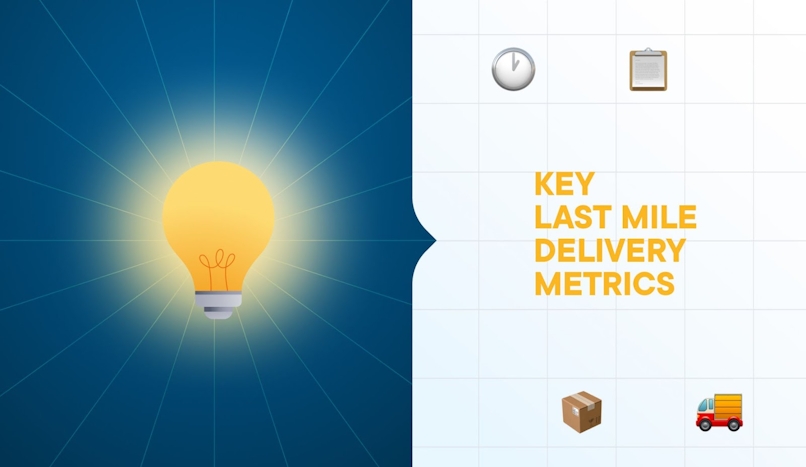10 Last-Mile Delivery Metrics You Need to Track in 2023
Last-mile delivery poses many challenges for logistics companies. See the key last-mile KPIs to track so you can spot problems and improve quickly.

Optimize your last-mile delivery performance with the Circuit for Teams suite of advanced tracking and management tools.
Are last-mile logistics the reason for your constant headache? We get that — and we imagine most other delivery companies feel your pain.
Unfortunately, ignoring the problem won’t make it go away. You don’t have a rug big enough to sweep it under, and neither do we.
Here’s another idea: What if you knew exactly which key performance indicators (KPIs) to track to improve the process and identify areas for potential improvement? Would that improve your team’s operational efficiency or bottom line?
If you answered “yes” to the last question, we’re glad you’re here. We’ll give you some of the best last-mile KPIs to track.
If we do our job well, you may even find a few smiles or chuckles along the way.
Key takeaways:
- Tracking last-mile KPIs can boost your team’s efficiency and help you save time and money.
- Choosing the right two to three KPIs to track is way more beneficial than measuring them all.
- Some of the best last-mile delivery KPIs to track include on-time deliveries, order accuracy, and customer satisfaction.
- On-time deliveries are essential to track, as a reliable delivery service increases customer satisfaction and brand loyalty.
- Order accuracy should be monitored, as it reflects whether customers' expectations are being met and can help in avoiding complaints and negative reviews.
- Customer satisfaction is important to measure as happy customers are more likely to become repeat customers and give positive reviews.
- Cost per mile is an easy metric to track and helps identify expenses related to last-mile delivery operations.
- Fuel consumption rate (FTR) measures the amount of fuel being used per vehicle per route, which can help reduce fuel waste and expenses.
- Empty miles should be minimized as they waste resources, fuel, and driver hours.
- Average service time (AST) considers the time spent on one order and helps cut down costs and become more efficient.
- First attempt delivery rate (FADR) indicates how many deliveries were successful on the first try, reducing costs and saving resources.
- Delivery attempts per stop (DAPS) identifies the number of times a driver attempts a delivery before succeeding and helps improve the delivery process.
- Delivery completion rate (DCR) measures the number of deliveries completed versus the number attempted and helps identify issues and improve the delivery process.
- Circuit for Teams will help you improve in various areas that you may want to track as KPIs, such as empty miles, average service time, and on-time deliveries.

10 key last-mile delivery metrics

We’ve got ten key last-mile delivery KPIs to tell you about today. Sit back, relax, and get ready to find the secret sauce to take your last-mile delivery metric tracking to the next level.
1. On-time deliveries
Here’s a simple question: Are your customers getting their stuff on time?
Obviously, a perfect on-time delivery rate should not be the goal here. You can’t guarantee that drivers never get stuck in traffic or hit every red light.
However, there’s a ton of value in knowing how often you complete on-time deliveries.
You may even want to track data for a few months and compare months against each other to discover how you’re improving (or slacking).
Customers may feel you aren’t reliable if you constantly arrive late and may look for other options. Think about how this impacts their perception of your business.
Another important thing is to get on the same page with the customer about when they expect their delivery. The truth is the customer decides whether the delivery is on time.
This is why it’s so helpful to use Circuit for Teams, which offers real-time tracking and updates about delivery times.
2. Order accuracy
If I order a pizza and you bring me a cheeseburger, I probably won’t be happy (even if I enjoy cheeseburgers). The fact is, you didn’t meet my expectations (plus, I don’t like mustard).
Maintaining order accuracy starts with acknowledging the customer’s expectations. Did the order come with special instructions? Will they be satisfied with what they get?
An easy way to measure this KPI is to divide the total number of orders by the total number of deliveries that you didn’t get an angry phone call or email about.
3. Customer satisfaction
Speaking of happy customers, that’s another important metric to track. Happy customers are more likely to become repeat customers and give you more money in the future. That’s a good outcome, right?
This metric incorporates some of the KPIs we’ve already discussed, but it also allows you to dig a little deeper. It’s not just about whether customers complain but about how happy they are with your service.
Here’s an example. Imagine a customer requests an off-day delivery. You roll your eyes because these are more expensive (and you aren’t caught up on new “Ted Lasso” episodes yet), but you want to please the customer, so you agree.
Assuming you don’t insult the customer’s mother or deliver a damaged item, they probably won’t have any complaints about the delivery experience. They may also report being highly satisfied instead of just plain “satisfied” with the customer experience.
This can create deeper brand loyalty and improve your chances of getting positive reviews and referrals from that customer.
4. Cost per mile
If you decrease your cost per mile, you’ll have more money to spend on office parties and breakroom snacks. You could also pay yourself and your employees more if that’s your jam.
It’s also a super-easy metric to track — just tally up the expenses from a specific period and divide them by the number of miles driven.
Remember to consider each of your expenses, including repairs, insurance, car washing, and those pesky toll fees.
5. Fuel consumption rate (FTR)
This one is a little tougher to measure, but don’t let that discourage you. There’s still potential to save money and improve delivery operations, even if you’re working from a rough estimate.
The purpose of this KPI is to figure out how much fuel you’re wasting. Perhaps you’ve heard that fuel costs are up right now. (If not, we’re sorry to be the bearers of bad news.)
The goal is to determine how much you spend on gas per vehicle per route. To do this, divide the distance driven by the fuel used.
Another trick is to fill your gas tank and drive until it’s empty. OK, not completely empty, but watch for that gas light.
Once you’re (almost) empty, fill your tank and write down how much gas it took. Reset your odometer, drive to nearly empty again, and divide the number of miles driven by how much gas you put in your car.
Congratulations, you now know your MPG (miles per gallon)! Feel free to start the process over to determine if the number is any higher or lower next time.
6. Empty miles
Empty miles are miles without a load, usually because your driver is returning from a delivery. Some of these miles are unavoidable, but too many empty miles waste resources.
Driving too many empty miles burns fuel, uses up driver hours, and puts unnecessary miles on your vehicles.
Want to reduce your team’s empty miles? Check out Circuit for Teams.
We created a platform that automatically performs route optimization to make your route planning as efficient as possible.
7. Average service time (AST)
AST considers the time you spend on one order. Whatever time it takes to get to the warehouse, fill out the paperwork, and get the item to the customer’s doorstep gets lumped into this category.
If you’re running multiple deliveries, you can divide the total time spent by the overall number of stops or deliveries. This gives you a breakdown of your average delivery time.
Circuit for Teams does this automatically — just enter each driver’s stops.
8. Damage claims
Where the hell did that dent come from??
Hopefully, you don’t deal with damage claims often, but they’re basically inevitable for anyone working in delivery.
To figure out how often they happen, simply choose a time frame and divide the number of damage claims by the total number of deliveries.
Reducing damage claims will keep customers happy and build brand credibility.
9. Capacity utilization
This is the “wasted space” KPI. It’s basically asking how much available space you’re using and how much sits open for no good reason.
To figure this one out, divide the available vehicle capacity by its total capacity. A bunch of available space on your deliveries likely means you’re not routing well.
At the same time, playing real-life Tetris every time you load up for a delivery means you may need to make some planning and logistical changes, as well.
10. Planned vs. actual mileage
How often does your actual mileage exceed your planned mileage? This happens when drivers get off track or when you don’t fully account for how far a driver goes on a specific route.
If this is something you experience often, you may need to improve how you plan your routes. Or you can just let Circuit for Teams do the heavy lifting for you.
How to choose the most important last-mile delivery metrics

OK, we know what you’re thinking. How the hell am I supposed to track ten metrics?
Yes, ten is a big number. But here’s the good news: Even if you only choose two or three to track, we think you’ll still notice an improvement.
Quality is the goal here, not quantity. Choosing two or three of the right metrics to track is WAY better than aiming for ten and doing a poor job.
Here are a few tips to help you nail down the right delivery service metrics to track:
- Focus on the team. You’ll get better results if you measure your entire team’s delivery performance rather than just one individual. Where are two or three areas where everyone (not just one person) could get better?
- Measure long-term trends. Measuring empty miles or capacity utilization on one single run won’t tell you much. Looking at data from an extended period paints a more accurate picture of your team’s performance.
- Choose something simple and effective. Seriously, we’re not trying to give you more busy work. We’re more interested in building on the good things you’re already doing. Don’t feel as though you have to reinvent the wheel here.
Find out how Circuit for Teams can streamline your last-mile delivery process
So, which KPIs are you going to measure? Remember that the goal isn’t to track everything, but to choose two or three metrics where a little improvement could go a long way for your delivery business.
Want more help with last-mile delivery? Check out Circuit for Teams. We’ve worked hard to build an awesome platform that helps you give fantastic service to your customers.
In addition to the features we told you about already, our software sends automatic notifications to customers so they know exactly when to expect their delivery.
We hope you’ll check it out. We think you’ll find that it saves you around 20 percent on your current delivery costs.




